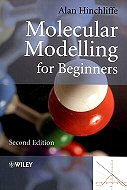Molecular Modelling for Beginners
Second Edition
|
|
Alan Hinchliffe
|

|

Molecular Modeling for Beginners, Second Edition is a concise, basic introduction to modelling and computational chemistry including relevant introductory material to ensure greater accessibility to the subject.
Partially updated from the first edition, chapters dealing with Monte Carlo and molecular dynamics, the GN models, transition states and solvent models have been completely rewritten. A new chapter entitled 'Sharing out the Energy' has been added to give a deeper understanding of the many statistical concepts discussed. All the illustrative examples contained in the text have been reworked using state of the art software. The associated website contains a number of relevant problem sets, together with suggested solutions.
The Appendix ('A Mathematical aide-memoire') gives relevant mathematical detail and can be used stand-alone.
Carefully structured and including many real chemical examples:
• The text begins by introducing the relevant fundamental theories of classical mechanics and classical electrostatics.
• These basic theories are then applied to modelling, concentrating on developing models from classical mechanics and focusing in particular on molecular mechanics.
• Attention then turns to statistical concepts, with a discussion of the basic methods of statistical thermodynamics.
• Monte Carlo and molecular dynamics are then treated in some depth.
• We then turn to quantum models, from simple quantum gases through fashionable density functional theory.
• With an entire chapter devoted to QSAR and discovery chemistry, the text successfully combines the essential theory with relevant applications and examples designed to encourage student understanding.
• The text ends with a discussion of transition states and hybrid models.
This text will appeal to students taking undergraduate courses in chemistry, pharmacy, biochemistry, chemical engineering and materials science. It may also be useful to students and researchers in departments of biology, physics and maths who are required to study molecular modelling as part of their course, and professionals who need a basic introduction to this increasingly important subject.
|
|
